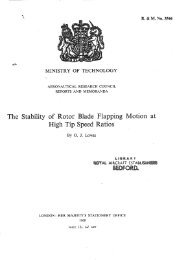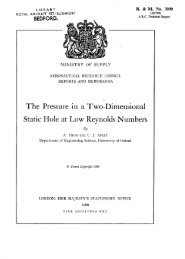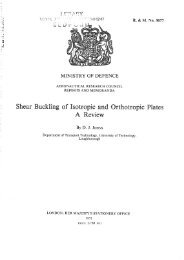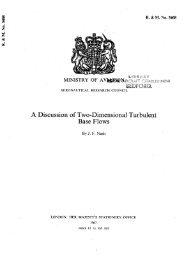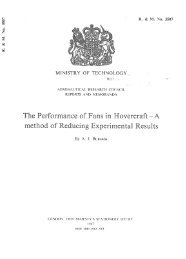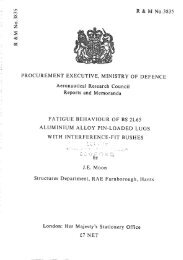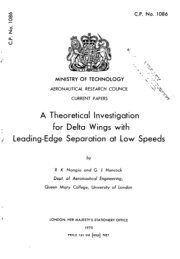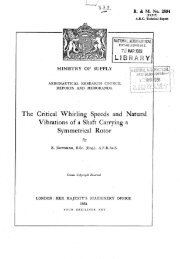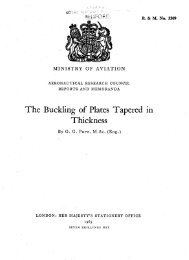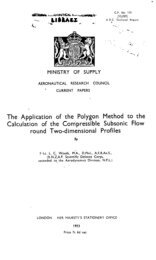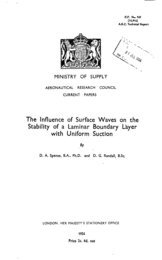Static and Dynamic Response of a Design of Differential ... - aerade
Static and Dynamic Response of a Design of Differential ... - aerade
Static and Dynamic Response of a Design of Differential ... - aerade
You also want an ePaper? Increase the reach of your titles
YUMPU automatically turns print PDFs into web optimized ePapers that Google loves.
corresponding to a maximum volume change <strong>of</strong> t&5%, end giving for this<br />
range <strong>of</strong> movement a capacity ch-%ge <strong>of</strong> aproxrmately 30 Iicr<strong>of</strong>srads.<br />
The yawmeter unit incorporating this pick-up is shown in fig.14: the<br />
length <strong>of</strong> tubing has been reduced from 20 inches to 5 inches, <strong>and</strong> the<br />
tubes are silver soldered to the pick-up. In this form the instrument<br />
1s self-contained rind suitable for fitting into a missile as a unit.<br />
In fig.16 is shorn the response <strong>of</strong> this version to a pressure pulse<br />
applied in still air conditions, <strong>and</strong>. the superposition <strong>of</strong> the two modes<br />
(em2tion 20) is quite apparent. The high frequency 1050 c.p.s.) lightly<br />
dsmped (z = 0.05) oscillation 1s the mechanical mode I verified by vibrating<br />
the pick-up in the absence <strong>of</strong> the yawmeter head), <strong>and</strong> the low frequency<br />
(126 c.P.s.) is that <strong>of</strong> the acoustic system. The latter agrees well with<br />
that given<br />
more than<br />
theoretically (123 c.p,s.) but the damping<br />
jC$ higher than the theoretical value.<br />
factor <strong>of</strong> 0.22 is<br />
Fig.17 sho?;s portions cf the response records resulting from a dis-<br />
turbance in both still air <strong>and</strong> at 1d = 1.4. IRvo resonance frequencies are<br />
apparent, one <strong>of</strong> alzproximately 1300 c.p.s. corresponding to that <strong>of</strong> the<br />
mechanical mode <strong>and</strong> another <strong>of</strong> about 130 c.p.s. which is consistant with<br />
that <strong>of</strong> the acoustic mode as calculated a.4 as measured in still air.<br />
Since these frequenoies are evident in both traces it indicates that the<br />
frequency invariance in still air <strong>and</strong> in the xind tunnel is realised in<br />
practice.<br />
The increase in the response frequencies with this pick-up compared<br />
with the bellrws type meant that at forcing frequencies <strong>of</strong> the order <strong>of</strong><br />
2 to 3 c.p.s. the change in amplitude ratio <strong>of</strong> input <strong>and</strong> output signal<br />
would be too small to use ir, conJunction with the phase lag to evaluate<br />
the acoustic u.n,f. <strong>and</strong> damping factor. However, hy taking the frequency .<br />
under tunnel conditions as that determined outside the tunnel, only the<br />
damping factor remains imknown., <strong>and</strong> this csn then be determined when the<br />
incidence is varied narmonically from a measurement <strong>of</strong> the phase shift<br />
above.<br />
Sinusoidal forcing programmes were applied <strong>and</strong> as already described<br />
the incidence <strong>and</strong> pressure pick-<strong>of</strong>f voltages applied to the oscilloscope.<br />
The beams, which were interrupted at ?CJO c.p.s. to provide a time base<br />
were adjusted so that with the yawmeter at zero incidence to the stream<br />
both coincided with a thin blanking strip on the face <strong>of</strong> the oscilloscope<br />
tube. A phase shift at zero incidence during any subsequent progransne<br />
was then shown by the time interval between treces <strong>of</strong> the separate beams<br />
crossing the blanked strip.<br />
In fig.18 are shoTen parts <strong>of</strong> such a trace greatly enlarged, with<br />
high gain on the pressure pick-up beam (hence the cut-<strong>of</strong>f except near the<br />
intersection), The yexmeter used in this case was sn interim version :<br />
(No.2) having the same pick-up <strong>and</strong> va,meter head as the later, built-in<br />
version (X0.6) but with a tube length <strong>of</strong> 20 inches instead <strong>of</strong> 5 inches.<br />
In the case shown the lag is seen to be 14 milliseconds. The theoretical<br />
relations <strong>of</strong> 4.1 predict a lag <strong>of</strong> O.OC3 seconds so that the indications<br />
are that the dampang obtained in practice with an oscillating instrument<br />
is roughly four times greater then the theoretical. Similar records were<br />
obtained with the shorter tube (built-in) version <strong>and</strong> the time lag was<br />
determined as 3 to 4 milliseconds. 30th long <strong>and</strong> short tube instruments<br />
thus show this fourfold increase in damning, <strong>and</strong> incidentally provide a<br />
direct check <strong>of</strong> part <strong>of</strong> the predictions <strong>of</strong> equation 22, in which the<br />
time lag was shown to be proportional to the length <strong>of</strong> connecting tube.<br />
- 26 -<br />
.



